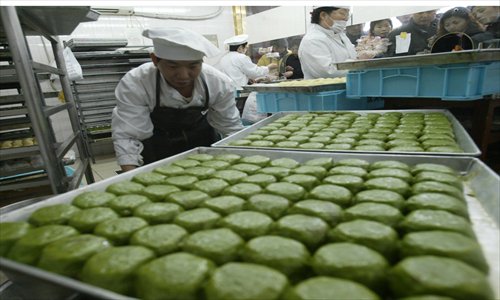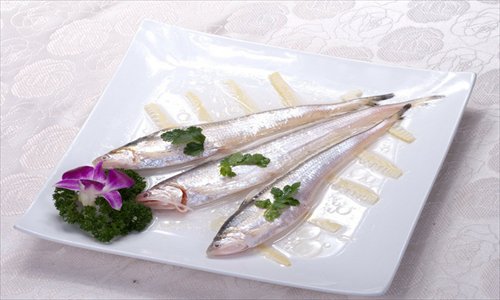A festive feast
Editor's note
The ancient Chinese created an agricultural solar system - still in use today - that is based upon their observation of crops, climate, astrology, and the study of animal and plant life cycles. The system guided farmers as to when to sow seeds and when to harvest them, and this system has now been in place for more than 2,000 years.
Today, with advances in science and technology, agriculture depends less on this ancient wisdom. But this seasonal calendar still operates as a reference guide for gourmands to seek out the best times for seasonal delicacies and for health experts to plan nutritious diets.
In a single year, the system features 24 "solar terms," each lasting one day and occurring every two weeks. Each has its own name and characteristics. The Global Times is presenting a weekly series examining which foods and delicacies are best enjoyed during these periods, as well as tips on preserving general health.
As this weekly column about solar terms approaches the end of a full cycle, we finally reach the only period among the 24 terms that is celebrated as a festival: qingming. The period - which always starts between April 4 and 6 - starts on April 4 this year. In ancient China, this was a time in which important agricultural decisions were made, but today qingming is better-known for the traditions of tomb-sweeping, ancestor worship, and spring outings.
Qingming, in the concept of traditional Chinese medicine (TCM), marks a time that separates cold and hot foods, meaning that after the festival people can start to eat cold food again because of the warmer weather. The Global Times has sought out some of Shanghai's century-old restaurants and food stores where you can enjoy some of the best cuisine during qingming.

Great balls of paste
Like zongzi for (glutinous rice dumplings) the Dragon Boat Festival and moon cakes for the Mid-Autumn Festival, qingtuan is a snack specifically associated with Qingming Festival. Coated with sticky rice and juice of wormwood (a herb that aids digestion), this green rice ball with sweet bean paste inside is a Shanghainese favorite for qingming.
Boasting that they sell more than 50,000 qingtuan daily during qingming, the 60-year-old Wang Jia Sha (805 Nanjing Road West, 6217-0625) sells all the traditional flavors and is also experimenting with new ones. The restaurant offers some 10 different fillings, including vegetable, pork and egg yolk, and pork floss.
Founded in 1909, Qiao Jia Shan is a Shanghai shop brand that specializes in local cuisine. Famous for its salty-flavored qingtuan that include sliced bamboo, pickles and pork stuffing, Qiao Jia Shan has long been a pioneer in the evolution of the traditional qingtuan. And you can buy their signature qingtuan at any of its branches in the city (including 162 Haichao Road, 3376-6407) or purchase its ready-to-go products at local supermarkets.
The vegetarian restaurant Godly (445 Nanjing Road West, 6327-0218) is an ideal choice for non-meat eaters during qingming. It offers three different qingtuan fillings: taro (a perfect balance of sweet root and savory wormwood juice), traditional red bean paste, and sugar-free red bean paste, for diabetics as well as those watching their waistlines.

Fish for all
It may not be especially designed for qingming, but it is definitely the most sought-after freshwater delicacy during this period. Literally translated as "knife fish" in English, daoyu is in its spawning season during qingming and this is also the best time for it to be served up on the dinner table. Once priced at 3,000 yuan ($482.70) per fish, this delicacy is as famous as an extravagant treat for the more wealthy among us.
However, there are spots in the city where people with lighter wallets can enjoy affordable daoyu. Lao Ban Zhai in Huangpu district (600 Fuzhou Road, 6322-3668) offers daoyu noodles for only 30 yuan. Although diners won't find any actual daoyu meat in the noodle sauce - because it has been cooked until the fish dissipates - the dish's savory daoyu flavor is still noticeable.
However, the price of smaller daoyu has dropped to between 200 yuan and 400 yuan per specimen this year, largely due to the collapse in price of many "luxury" items since austerity measures were recently introduced by the central government. So now, a plate of homemade daoyu is affordable for many people in Shanghai. And to preserve the natural taste of daoyu, steaming is the best way to cooking this fish.
Steamed daoyu
Ingredients: 1,250 grams daoyu, 15 grams ham, 20 grams bamboo shoots, 25 grams yellow rice wine, 5 grams ginger, 10 grams green onions
Steps:
Put a pair of chopsticks into the stomach of the fish through its mouth and remove the guts (as the scales of daoyu are edible, try to keep the rest of the body intact)
Clean the fish thoroughly
Put the fish on a plate and cover with the ham, bamboo shoots, ginger and green onions
Add a teaspoon of salt and the yellow rice wine
Steam the fish for 15 minutes
Add in sesame oil and soy sauce if you like stronger flavors